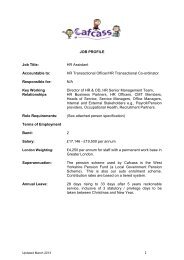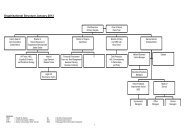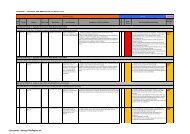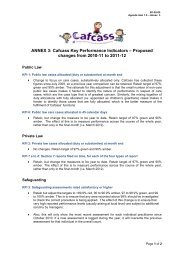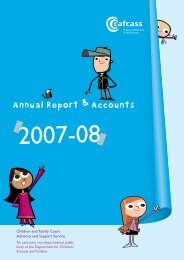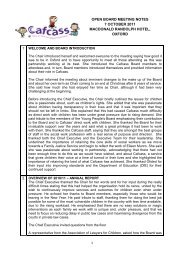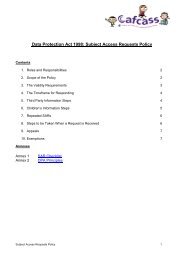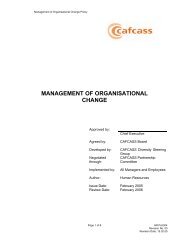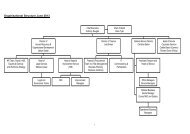Guidance for Adoption Proceedings and Section 84 ... - Cafcass
Guidance for Adoption Proceedings and Section 84 ... - Cafcass
Guidance for Adoption Proceedings and Section 84 ... - Cafcass
Create successful ePaper yourself
Turn your PDF publications into a flip-book with our unique Google optimized e-Paper software.
<strong>Guidance</strong> <strong>for</strong> <strong>Adoption</strong> <strong>Proceedings</strong> <strong>and</strong> <strong>Section</strong> <strong>84</strong> <strong>Proceedings</strong>Overview of <strong>Guidance</strong>This policy explains the role of the Children's Guardian <strong>and</strong> Children <strong>and</strong> Family Reporter in<strong>Adoption</strong> Order proceedings, <strong>and</strong> <strong>Section</strong> <strong>84</strong> proceedings under the Children <strong>and</strong> <strong>Adoption</strong>Act 2002.Contents1.0 Introduction 22.0 Legal Framework <strong>for</strong> <strong>Adoption</strong> Order <strong>Proceedings</strong> 23.0 The Role of the Children’s Guardian in <strong>Adoption</strong> Order <strong>Proceedings</strong> 74.0 Role <strong>and</strong> Duty of the Children <strong>and</strong> Family Reporter in <strong>Adoption</strong> <strong>Proceedings</strong> 125.0 Application <strong>for</strong> a <strong>Section</strong> <strong>84</strong> Order 136.0 The Children’s Guardian Role in <strong>Section</strong> <strong>84</strong> <strong>Proceedings</strong> 13<strong>Guidance</strong> <strong>for</strong> <strong>Adoption</strong> <strong>Proceedings</strong> Full implementation by 2011 Page 1 of 14<strong>and</strong> <strong>Section</strong> <strong>84</strong> <strong>Proceedings</strong>
1.0 Introduction1.1 The purpose of this guidance is to explain the legal framework <strong>for</strong> adoption under theChildren <strong>and</strong> <strong>Adoption</strong> Act 2002 <strong>and</strong> the consequences of an adoption order as wellas setting out the professional duties of the Children's Guardian <strong>and</strong> the Children <strong>and</strong>Family Reporter as they relate to adoption proceedings. The guidance also explainsthe legal framework <strong>for</strong> <strong>Section</strong> <strong>84</strong> applications (which is an application <strong>for</strong> parentalresponsibility prior to adopting a child abroad) although the duties of the Children'sGuardian remain the same as in <strong>Adoption</strong> Order proceedings.1.2 There are two types of adoption proceedings where a Children's Guardian or Child<strong>and</strong> Family Reporter might be appointed, they are:Agency adoptions - where the child was placed <strong>for</strong> adoption by an adoptionagency - which is almost always a local authority; <strong>and</strong>,Non-agency adoptions - partner (otherwise known as stepparent) adoptions,adoption by relatives or foster carers, <strong>and</strong> others where the child was not placed<strong>for</strong> adoption by an agency.2.0 The Legal FrameworkParents <strong>and</strong> Guardians2.1 The term 'parent' in this guidance refers to birth parents with parental responsibility<strong>for</strong> the child; the term 'guardian' includes Special Guardians of the child.<strong>Adoption</strong> Order2.2 The effect of an <strong>Adoption</strong> Order is to end all parental responsibility of any person orlocal authority, <strong>and</strong> place it with the adopters, who then hold full <strong>and</strong> sole parentalresponsibility <strong>for</strong> the child.2.3 An <strong>Adoption</strong> Order also ends any Children Act 1989 Order, such as a CareOrder, a contact order, a Residence Order or a Special Guardianship Order,although new section 8 contact orders can be made with <strong>Adoption</strong> Orders. The<strong>Adoption</strong> Order will also end a Placement Order or <strong>Section</strong> 26 contact orders.2.4 Where a Placement Order is in <strong>for</strong>ce, or a parent or guardian has given consentto placement <strong>for</strong> adoption 1 , which has not been withdrawn, parents <strong>and</strong> guardiansmay only oppose the making of an <strong>Adoption</strong> Order with the leave of court. Leavewill only be granted if the court is satisfied that there has been a change incircumstances that justify leave being given in the interests of the child. The Actdoes not specify which circumstances must have changed, <strong>for</strong> example, those ofthe child, parent or guardian or adopters.1 <strong>Section</strong> 19 Consent<strong>Guidance</strong> <strong>for</strong> <strong>Adoption</strong> <strong>Proceedings</strong> Full implementation by 2011 Page 2 of 14<strong>and</strong> <strong>Section</strong> <strong>84</strong> <strong>Proceedings</strong>
2.5 <strong>Section</strong> 1(6) of the Act provides that the court can only make an <strong>Adoption</strong> Orderwhere it considers that doing so is better <strong>for</strong> the child than not doing so. Whenconsidering the application <strong>for</strong> an <strong>Adoption</strong> Order the court must consider all thealternative orders available under the <strong>Adoption</strong> <strong>and</strong> Children Act 2002 as well asthe Children Act 1989, <strong>and</strong> the option of not making any order.Grounds on which <strong>Adoption</strong> Order Can be made2.6 An <strong>Adoption</strong> Order can only be made in the circumstances set out in either (a),(b) or (c);a) The court is satisfied that each parent or guardian of the child:consents to the making of the <strong>Adoption</strong> Order, or;has consented under section 20 <strong>and</strong> does not oppose the making of the<strong>Adoption</strong> Order 2 , orconsent should be dispensed with.b) The court is satisfied that (in local authority agency adoptions) that the child;has been placed <strong>for</strong> adoption by a local authority with the prospectiveadopters with whom the order is proposed to be made, <strong>and</strong> either:was placed <strong>for</strong> adoption with the consent of each parent or guardian, theconsent of the mother was given when the child was at least six weeks old,<strong>and</strong> the consent(s) were not withdrawn be<strong>for</strong>e the <strong>Adoption</strong> Order wasapplied <strong>for</strong> 3 , orThe child was placed <strong>for</strong> adoption under a Placement Order, <strong>and</strong> no parent orguardian has been given leave to oppose the making of the <strong>Adoption</strong> Order.c) The third is that the child is free <strong>for</strong> adoption.2.7 The court will not make an <strong>Adoption</strong> Order unless it is satisfied that there have beensufficient opportunities by the local authority to see the child with the prospectiveadopter(s) 4 . These visits are part of the investigation leading to the local authorityAnnex A court report 5 .2 A parent or guardian may not oppose the making of an adoption order under subsection (b) without the court’sleave3 A parent or guardian may not oppose the making of an adoption order under subsection (b) without the court’sleave4 If a couple are adopting this must be with both prospective adopters5 A child who is the subject of an adoption order application is not a ‘protected’ child. The Local Authority’s duty isspecifically to investigate the child’s circumstances <strong>and</strong> report about whether the adoption order applied <strong>for</strong> is inthe child’s best interests<strong>Guidance</strong> <strong>for</strong> <strong>Adoption</strong> <strong>Proceedings</strong> Full implementation by 2011 Page 3 of 14<strong>and</strong> <strong>Section</strong> <strong>84</strong> <strong>Proceedings</strong>
Timing of the Application <strong>for</strong> an <strong>Adoption</strong> Order2.8 The decision to apply <strong>for</strong> adoption is usually agreed between the child (if s/he is ofsufficient underst<strong>and</strong>ing), the prospective adopters, <strong>and</strong> the local authority (if it is alocal authority placement). However, the prospective adopters do not need theapproval of the local authority or the Independent Reviewing Officer to make theirapplication.2.9 The timing of the application <strong>and</strong> the need <strong>for</strong> notification of intention to apply <strong>for</strong> the<strong>Adoption</strong> Order will depend on the nature of the placement;In Local Authority adoptions the adopters can apply <strong>for</strong> an <strong>Adoption</strong> Order afterthe child has lived with them <strong>for</strong> at least ten weeks. Notification of intention is notrequiredIn Non-Agency adoptions the time periods of the child living with theapplicant(s) be<strong>for</strong>e the application can be made are:oooooPartner adoptions - six monthsLocal authority foster carers - twelve monthsRelatives - three yearsInter-country adopters - six months if they have complied with regulations,twelve months if notOther non-related persons (e.g. private foster carers) - three years.(The court can give leave <strong>for</strong> an application to be made earlier than these time limitsin non- local authority adoptions).2.10 Non-agency prospective adopters must give notice to the local authority of theirintention to apply <strong>for</strong> an <strong>Adoption</strong> Order. The minimum notice period is three monthsbe<strong>for</strong>e the application can be made <strong>and</strong> the maximum notice period is two yearsbe<strong>for</strong>e the application is made.Consent in Local Authority <strong>Adoption</strong>s2.11 One of the legal consequences of a Placement Order or <strong>Section</strong> 19 consent is thatparents <strong>and</strong> guardians will not be able to oppose the making of the <strong>Adoption</strong> Orderunless they are given leave of the court to do so. Leave will only be granted by thecourt if it is satisfied that there has been a change in circumstances which justifiesthe giving of leave in the interests of the child. It is essential there<strong>for</strong>e that theparents <strong>and</strong> guardians are kept in<strong>for</strong>med by the local authority if they are to knowwhether there has been a change in circumstances.Dispensing with Consent<strong>Guidance</strong> <strong>for</strong> <strong>Adoption</strong> <strong>Proceedings</strong> Full implementation by 2011 Page 4 of 14<strong>and</strong> <strong>Section</strong> <strong>84</strong> <strong>Proceedings</strong>
2.12 In both agency <strong>and</strong> non-agency adoption, if the parents do not consent <strong>and</strong> allrelevant leave has been given, the prospective adopters must ask the court todispense with parental consent on one of the following grounds:The parent or guardian cannot be found or is incapable of giving consent, orThe welfare of the child requires the consent to be dispensed with(The applicant(s) <strong>for</strong> the <strong>Adoption</strong> Order have the burden of proof that these groundsare made out.)2.13 In circumstances where the adoption is contested the Children's Guardian or Child<strong>and</strong> Family Reporter's advice to the court as to whether the welfare of the childrequires the parental consent to be dispensed with is a crucial safeguard <strong>for</strong> thechild. The Guardian will assist the court in considering 5 key factors:Is the paramount factor in the court's decision the child's welfare, throughout hisor her life?Has the welfare checklist been applied?What arrangements are necessary <strong>for</strong> contact, if any?is the order necessary <strong>and</strong> proportionate?Would any other order adequately promote the welfare of the child?The Local Authority Report – Annex A2.14 When an application <strong>for</strong> an <strong>Adoption</strong> Order is made, in both local authority <strong>and</strong> nonagencyadoptions, the local authority must prepare a report (referred to as the AnnexA Report) on the suitability of the adopters <strong>and</strong> whether adoption is in the bestinterests of the child. In assessing the child's best interests the report should addressthe ACA 2002 welfare checklist.2.15 In non-agency adoptions, the best practice is <strong>for</strong> local authorities to begin preparingthe Annex A report when the notice of intention is given, <strong>and</strong> be<strong>for</strong>e the applicationcan be made. This will allow the local authority time to discuss with the prospectiveadopters possible alternative orders which could potentially be more in the interestsof a child.The Potential Outcomes of an <strong>Adoption</strong> Order Application2.16 The potential options <strong>for</strong> non-agency adoptions are:a) An <strong>Adoption</strong> Order places parental responsibility (PR) solely with the adopters<strong>and</strong> ends the PR of the birth parents - creating a lifelong legal relationshipbetween the adopters <strong>and</strong> the child<strong>Guidance</strong> <strong>for</strong> <strong>Adoption</strong> <strong>Proceedings</strong> Full implementation by 2011 Page 5 of 14<strong>and</strong> <strong>Section</strong> <strong>84</strong> <strong>Proceedings</strong>
) The alternative <strong>for</strong> married or civil registered partners of birth parents, thealternatives to adoption are;A Parental Responsibility Agreement 6 ; or,A Parental Responsibility Order 7 .c) The alternative <strong>for</strong> partners who are not married or civil registered partners of thebirth parent is a Residence Order - lasting until the child is 16 or the order isdischarged. The court can extend the order until the child is eighteen. The partnerwill acquire parental responsibility <strong>for</strong> the child which is shared equally with allother holders of PR, but the Residence Order determines with whom the childlives.d) The partner of a birth parent can only apply <strong>for</strong> a Special Guardianship Order ifleave of court is given (although special guardianship is not likely to be analternative to adoption <strong>for</strong> most partner adoptions).2.17 In the case of other relatives such as gr<strong>and</strong>parents or non-related prospectiveadopters such as foster carers the alternatives to adoption are;a) A Residence Order (<strong>for</strong> details see 2.16), orb) A Special Guardianship Order - lasting until 18 unless the order is discharged.The special guardians share PR with the birth parents <strong>and</strong> guardians <strong>and</strong> theorder lasts until 18 unless it is discharged. The special guardians can exercisePR to the exclusion of parents <strong>and</strong> guardians on most issues.2.18 The potential options <strong>for</strong> children placed by local authorities (subject to PlacementOrders or section 19 consent) are:a) An <strong>Adoption</strong> Order (<strong>for</strong> detail 2.16)b) A Special Guardianship Order (<strong>for</strong> detail see 2.16)c) A Residence Order (<strong>for</strong> detail see 2.16)d) Revocation of the Placement Order - any Care Order made prior to thePlacement Order will revive, <strong>and</strong> allows PR to be shared by the birth parent(s)<strong>and</strong> the local authority until the child is 18 or the order is discharged.2.19 The child's wishes <strong>and</strong> feelings are integral to any decisions <strong>and</strong> must in<strong>for</strong>m theplans <strong>for</strong> the future. The use of the needs, wishes <strong>and</strong> feelings pack will be a usefultool to work through with the child to explore the nature of the relationships between6 Parental responsibility is shared equally with all others who have PR7 Parental responsibility is shared equally with all others who have PR<strong>Guidance</strong> <strong>for</strong> <strong>Adoption</strong> <strong>Proceedings</strong> Full implementation by 2011 Page 6 of 14<strong>and</strong> <strong>Section</strong> <strong>84</strong> <strong>Proceedings</strong>
the child <strong>and</strong> other parties involved. Some children may not want to be adopted, evenif they know that their parents cannot care <strong>for</strong> them, they may want their legalrelationship with their birth family preserved. For other children, especially those whohave been abused, the security, permanence <strong>and</strong> sense of belonging of adoptionmay be crucial to their emotional well being.The Court2.20 Prospective adopters can make their application to any court - it is not necessary toapply to the court which granted any previous orders. An application <strong>for</strong> an <strong>Adoption</strong>Order can be made to any Magistrates (Family <strong>Proceedings</strong>) Court, County Court<strong>Adoption</strong> Centre or the High Court.The Legal Effect of the Application2.21 The application prevents an accommodated child being removed by the localauthority or the parents <strong>and</strong> guardians, unless the court gives permission, or the localauthority needs to exercise its statutory powers because of significant harm to thechild.The Child as a Party2.22 Unlike in Placement Order proceedings, a child is not automatically a party to<strong>Adoption</strong> Order proceedings. The court rules provide that the child will be partywhen 8 :Permission has been granted by a court <strong>for</strong> parents or guardians to oppose themaking of the <strong>Adoption</strong> OrderThe child opposes the making of the <strong>Adoption</strong> OrderA Child <strong>and</strong> Family Reporter recommends that it is in the best interests of thechild to be a party to the proceedings <strong>and</strong> that recommendation is accepted bythe courtThe child is already an adopted childThe prospective adopters are relatives of the child, (other than a partner of a birthparent)Any party to the proceedings or the child is opposed to the arrangements <strong>for</strong>allowing proposed contact, or a person not being allowed contact with the childafter the making of the <strong>Adoption</strong> Order.2.23 In inter-country adoptions the child will be party when:The application is <strong>for</strong> a Convention <strong>Adoption</strong> Order or a section <strong>84</strong> order8 Rule 14.3 FPR 2010<strong>Guidance</strong> <strong>for</strong> <strong>Adoption</strong> <strong>Proceedings</strong> Full implementation by 2011 Page 7 of 14<strong>and</strong> <strong>Section</strong> <strong>84</strong> <strong>Proceedings</strong>
The child has been brought into the United Kingdom in the circumstances wheresection 83(1) applies (restriction on bringing children in)The application is <strong>for</strong> an <strong>Adoption</strong> Order other than a Convention <strong>Adoption</strong> Order<strong>and</strong> the prospective adopters intend the child to live in a country or territoryoutside the British Isl<strong>and</strong>s after the making of the <strong>Adoption</strong> Order.3.0 The Role of the Children’s Guardian in <strong>Adoption</strong> Order <strong>Proceedings</strong>3.1 The role <strong>and</strong> duties of the Children's Guardian are set out in Rules 16.3, 16.18 to16.21 of The Family Procedure Rules 2010 <strong>and</strong> Practice Direction 16A.3.2 When the court decides to make a child a party to the adoption proceedings aChildren's Guardian will be appointed, unless the court is satisfied that it is notnecessary to do so in order to safeguard the interests of the child 9 .3.3 At any stage in proceedings where the child is a party, the court can appoint aChildren's Guardian if an application is made by a party to the proceedings or, thecourt on its own initiative may wish to appoint a Children’s Guardian <strong>for</strong> the child.3.4 When appointing a Guardian the court will usually request the appointment of thesame Children's Guardian who was previously appointed <strong>for</strong> the child.The Duties3.5 In safeguarding the interests of the child the Children's Guardian must appoint asolicitor <strong>for</strong> the child unless a solicitor has already been appointed. In particular theGuardian must:Instruct the solicitor representing the child, advising him or her on all mattersrelevant to the interests of the child, including the possibility <strong>for</strong> an appeal duringproceedingsMeet with the child to underst<strong>and</strong> his/her views, needs, wishes <strong>and</strong> feelings aboutthe plans <strong>for</strong> the future <strong>and</strong> on what is happening at courtGive advice to the child as is appropriate having regard to his/her underst<strong>and</strong>ingContact or seek to interview persons whom s/he thinks appropriate or as thecourt directsMake investigations as are necessary to carry out her/his dutiesObtain such professional assistance as appropriate or which the court directs9 Rule 6.23 <strong>and</strong> Rule 14.5 FPR 2010<strong>Guidance</strong> <strong>for</strong> <strong>Adoption</strong> <strong>Proceedings</strong> Full implementation by 2011 Page 8 of 14<strong>and</strong> <strong>Section</strong> <strong>84</strong> <strong>Proceedings</strong>
Advise the court on the child's ability to underst<strong>and</strong> the nature of proceedings,including the child's views about undertaking particular assessments orexaminationsAdvise the court as to the appropriate <strong>for</strong>um <strong>and</strong> timings <strong>for</strong> the proceedingsAdvise the court of the most suitable options - from those available - <strong>for</strong> theparticular childAny other matter on which the court seeks his/her advice or on which s/heconsiders that the court should be in<strong>for</strong>medFile a written report with the court unless the court directs otherwise, advising onthe interests of the child in accordance with the timetable set by the court.3.6 The role of the Children's Guardian is to safeguard the welfare of the child inadoption proceedings. The welfare issues, which have led the court to make the childa party to proceedings, will guide the Guardian's investigation. The Guardian mustapply the <strong>Adoption</strong> <strong>and</strong> Children Act (2002) welfare checklist to the issues in thecase, <strong>and</strong> consider whether the <strong>Adoption</strong> Order appears to be the one most likely tosecure the welfare of the child as opposed to the other alternatives available to thecourt.3.7 Be<strong>for</strong>e the court makes an <strong>Adoption</strong> Order, it must consider contact arrangements<strong>and</strong> hear the views of all parties. The Children’s Guardian must advise the court as towhether in the interests of the child, any contact arrangements should be considered,including in some cases no arrangements <strong>for</strong> contact. The Guardian should highlight<strong>for</strong> the court any existing or proposed arrangements so that the court hears thechild's views about her/his future contact needs 10 .3.8 Post adoption contact can take the <strong>for</strong>m of:Indirect contact - exchange of in<strong>for</strong>mation, such as photographs or letters,through a confidential adoption agency letter box service, or a one way provisionof in<strong>for</strong>mation to be held in a letter box facilityDirect contact - <strong>for</strong> example, a face to face meeting, phone calls <strong>and</strong> otherelectronic communications. The court can consider establishing agreements orundertakings about contact, or make a <strong>Section</strong> 8 order <strong>for</strong> both direct <strong>and</strong> indirectcontact.3.9 When considering contact arrangements, careful consideration must be given as towhether the contact will be supportive to the placement, as research suggests it canbe in some cases (Post <strong>Adoption</strong> Contact Research). The potential risks that contactcould undermine the relationship between the child <strong>and</strong> adopters will also need to beconsidered, as will the frequency <strong>and</strong> type of contact <strong>and</strong> how it should be h<strong>and</strong>led10 <strong>Section</strong> 46 (6) ACA 2002<strong>Guidance</strong> <strong>for</strong> <strong>Adoption</strong> <strong>Proceedings</strong> Full implementation by 2011 Page 9 of 14<strong>and</strong> <strong>Section</strong> <strong>84</strong> <strong>Proceedings</strong>
with the child, arrangements to review contact, <strong>and</strong> contingency plans in case ofdifficulties.Other Potential Parties3.10 As part of the Guardian's analysis, s/he must, consider if there are any other peoplein the child's life who are important to the child <strong>and</strong> could have a role to play insafeguarding the child's interests. If the Children's Guardian is able to identifysomeone of importance to the child <strong>and</strong> it appears that their role in the child's life hasnot been sufficiently considered by the local authority, the Guardian must; advise theperson that it may be possible <strong>for</strong> them to join proceedings 11 , <strong>and</strong> they should takelegal advice.<strong>Adoption</strong> Support3.11 Under the <strong>Adoption</strong> Support Services Regulation 2005, local authorities have theduty to assess support needs <strong>and</strong> discretion as to provide support to adoptivefamilies. The support services are:Financial support - including ongoing payments or lump sums, introductory <strong>and</strong>settling in expenses, court fees <strong>and</strong> legal costsSupport groups <strong>for</strong> adoptive parents <strong>and</strong> adoptive childrenSupport <strong>for</strong> contact arrangements between adoptive children <strong>and</strong> their birthrelatives or with other people with whom they share significant relationshipsTraining <strong>for</strong> adopters in meeting their child's needsTherapeutic services <strong>for</strong> childrenServices to ensure the success of the adoptive placement or adoptionCounselling, advice <strong>and</strong> in<strong>for</strong>mation (this support can also be provided to non -agency adoptive families).3.12 Regulations require that the local authority plan ahead <strong>for</strong> adoption support at eachstage of placement <strong>and</strong> adoption. The Children’s Guardian has an important role toplay in checking that appropriate support services <strong>and</strong>, where relevant, plans are inplace at the <strong>Adoption</strong> Order application <strong>and</strong> that there are clear arrangements inh<strong>and</strong> <strong>for</strong> provision after the <strong>Adoption</strong> Order, where appropriate. For furtherin<strong>for</strong>mation on post adoption support refer to St<strong>and</strong>ards <strong>for</strong> <strong>Adoption</strong> Support.Separate Legal Representation <strong>for</strong> the Child 1211 Rule 14.3 FPR 201012 Practice Direction 16A<strong>Guidance</strong> <strong>for</strong> <strong>Adoption</strong> <strong>Proceedings</strong> Full implementation by 2011 Page 10 of 14<strong>and</strong> <strong>Section</strong> <strong>84</strong> <strong>Proceedings</strong>
3.13 If the child's solicitor, having taken into account the views of the Children's Guardian<strong>and</strong> any direction of the court considers that:3.13.1 The child wishes to give instructions which conflict with those of theChildren's Guardian; <strong>and</strong>3.13.2 S/he has sufficient age <strong>and</strong> underst<strong>and</strong>ing, to give such instructions onher/his own behalf.3.13.3 The solicitor will conduct the proceedings in accordance with instructionsreceived from the child. In these circumstances the Children's Guardianmay apply to the court <strong>for</strong> permission to have legal representation in theproceedings, this would be arranged through CAFCASS Legal 13 .Attendance at Hearings3.14 The Children's Guardian or the solicitor <strong>for</strong> the child must attend all directionshearings unless the court directs otherwise.3.15 The court must notify birth parents <strong>and</strong> guardians of the final hearing date of the<strong>Adoption</strong> Order. Parents <strong>and</strong> guardians are entitled to attend the court <strong>and</strong> be heardon whether the <strong>Adoption</strong> Order should be granted, even if they have not applied <strong>for</strong>leave to oppose 14 , other than when birth parents request not to be notified, or thechild has been freed <strong>for</strong> adoption.3.16 The Children's Guardian <strong>and</strong> child's solicitor should establish during directionshearings what arrangements have been made about the management of the courthearing, such as ascertaining if parents <strong>and</strong> guardians will attend, <strong>and</strong> making surethat everyone is safe at the court <strong>and</strong> their confidentially maintained.3.17 An important aspect of ensuring safety <strong>and</strong> confidentiality <strong>for</strong> the child <strong>and</strong> theProspective adopters is the confidentiality of court reports.3.18 Although any report in adoption proceedings cannot be disclosed, even to otherparties without the permission of the court 15 . The court must consider whether anyin<strong>for</strong>mation should be deleted, <strong>for</strong> example, in<strong>for</strong>mation likely to disclose, the identity<strong>and</strong>/or address of the child or adoptive applicants. The Children's Guardian or CFRshould there<strong>for</strong>e highlight <strong>for</strong> the court any in<strong>for</strong>mation in their report which shouldremain confidential if reports are disclosed, in order to ensure a child is safeguarded<strong>and</strong> his/her welfare prioritised.13 Rule 16.21 FPR 201014 Rule 14.13 FRP 201015 Rule 77<strong>Guidance</strong> <strong>for</strong> <strong>Adoption</strong> <strong>Proceedings</strong> Full implementation by 2011 Page 11 of 14<strong>and</strong> <strong>Section</strong> <strong>84</strong> <strong>Proceedings</strong>
3.19 It is good practice at the final hearing, <strong>for</strong> the Children's Guardian to write a letter,which can be kept on the court file <strong>for</strong> the child in the interests of his/her later lifeneeds 16 .Communicating the Court’s Decision to the Child3.20 The Children's Guardian will ensure that planning has been made to in<strong>for</strong>m the childof the court's decision <strong>and</strong> the outcome of that decision <strong>for</strong> his/her life is explained tothe child. This last meeting between the Children’s Guardian <strong>and</strong> the child also givesthe child opportunity to have closure <strong>and</strong> say goodbye.4.0 Role <strong>and</strong> Duties of the Child <strong>and</strong> Family Report in <strong>Adoption</strong> <strong>Proceedings</strong>4.1 The role <strong>and</strong> duties of the Children <strong>and</strong> Family Reporter in adoption proceedings areset out in Rule 16.33 FPR 2010 <strong>and</strong> Practice Direction 16A.Appointment of a Child <strong>and</strong> Family Reporter4.2 In adoption proceedings the court may ask a Children <strong>and</strong> Family Reporter (CFR) toprepare a report 'on matters relating to the welfare of the child'. The CFR isappointed to safeguard the welfare of the child who is the subject of the <strong>Adoption</strong>Order proceedings. As the child is not a party, the CFR does not appoint a solicitor<strong>for</strong> the child.The Duties4.3 The duties of the CFR are very similar to those of the Children's Guardian <strong>and</strong> mustinclude considerations about contact <strong>and</strong> adoption support. To see the full list ofduties refer to 3.6 of this guidance. However, a particular duty of the CFR is to:Consider whether it is in the best interests of the child to be made a party to theproceedings, <strong>and</strong> if so, notify the court of his/her opinion together with thereasons <strong>for</strong> that opinion.The Role of the Child <strong>and</strong> Family Reporter4.4 The role of the CFR is to safeguard the welfare of the child in adoption proceedingsthrough the investigation of the specific welfare issues considering the impact offuture plans <strong>for</strong> the child.4.5 The CFR must meet with the child, to discuss the analysis of the circumstances ofcase <strong>and</strong> the contents of the report (subject to the child's age <strong>and</strong> underst<strong>and</strong>ing)including any reference in the report about the child's views on the application.16 For all adoptions on or after 30 th December 2005, the adopted adult has a legal right to see the court’s recordsof their adoption including the application <strong>for</strong>m (but not the documents attached to it), the Annex A <strong>and</strong> <strong>Cafcass</strong>Report<strong>Guidance</strong> <strong>for</strong> <strong>Adoption</strong> <strong>Proceedings</strong> Full implementation by 2011 Page 12 of 14<strong>and</strong> <strong>Section</strong> <strong>84</strong> <strong>Proceedings</strong>
4.6 Like the report of the Guardian, the confidentiality of the CFR's report is an essentialaspect of safety planning <strong>for</strong> the child <strong>and</strong> the prospective adopters. The CFR shouldhighlight <strong>for</strong> the court any in<strong>for</strong>mation which should remain confidential if his/herreport is disclosed in order to ensure a child is safeguarded <strong>and</strong> his/her welfareprioritised.4.7 Like the role of the Guardian, the CFR should also establish during directionshearings what arrangements have been made <strong>for</strong> the court hearing as outlined in3.17 of this guidance, <strong>and</strong> plans as to how the outcome of the case will becommunicated to court.5.0 Application <strong>for</strong> a <strong>Section</strong> <strong>84</strong> Order5.1 A <strong>Section</strong> <strong>84</strong> order gives parental responsibility to prospective adopters prior to themtaking the child abroad specifically <strong>for</strong> adoption. An application <strong>for</strong> a <strong>Section</strong> <strong>84</strong> ordermust be made to the High Court.Legal Framework5.2 The law <strong>and</strong> procedure follows the <strong>for</strong>mat of a local authority adoption. There<strong>for</strong>e, theprospective adopters will have been approved as adopters according to the law in thecountry where they live. The UK local authority will have complied with regulations todetermine that, placement with <strong>and</strong> adoption abroad, by these applicants is in thechild's best interests.5.3 The child will always be a party to this application <strong>and</strong> a Children's Guardian <strong>and</strong>Solicitor will be appointed.Timing of an application5.4 An application <strong>for</strong> a section <strong>84</strong> Order cannot be made until the prospective adoptershave lived with the child <strong>for</strong> at least 10 weeks in the UK.6.0 The Children’s Guardian Role in <strong>Section</strong> <strong>84</strong> <strong>Proceedings</strong>6.1 The role <strong>and</strong> duties are the same as in <strong>Adoption</strong> Order proceedings; refer to detailedguidance at 3.6 & 3.7 of this guidance.6.2 Be<strong>for</strong>e making a section <strong>84</strong> order, the court must consider whether there should bearrangements <strong>for</strong> allowing any person contact with the child; <strong>and</strong> <strong>for</strong> that purpose thecourt must consider any existing or proposed arrangements <strong>and</strong> obtain any views ofthe parties to the proceedings 17 .6.3 Contact arrangements might be similar to those proposed in adoption applicationrefer to further guidance at 3.8 – 3.10.17 <strong>Section</strong> 46 (6) ACA, 2002<strong>Guidance</strong> <strong>for</strong> <strong>Adoption</strong> <strong>Proceedings</strong> Full implementation by 2011 Page 13 of 14<strong>and</strong> <strong>Section</strong> <strong>84</strong> <strong>Proceedings</strong>
6.4 The appointment of the Children's Guardian or CFR ends at the conclusion of theproceedings. The Children’s Guardian will make arrangements to in<strong>for</strong>m the child ofthe outcome <strong>and</strong> say goodbye to the child.6.5 It is good practice that at the end of the appointment of the CFR - if there is noappointment of a Guardian - <strong>for</strong> the CFR to write a letter, which can be kept on thecourt file <strong>for</strong> the child in the interests of his/her later life needs 18 .OwnerBruce ClarkIssued 2011Version 2.0Next Review September 201218 For all adoptions on or after 30 th December 2005, the adopted adult has a legal right to see the court’s recordsof their adoption including the application <strong>for</strong>m (but not the documents attached to it), the Annex A <strong>and</strong> <strong>Cafcass</strong>Report<strong>Guidance</strong> <strong>for</strong> <strong>Adoption</strong> <strong>Proceedings</strong> Full implementation by 2011 Page 14 of 14<strong>and</strong> <strong>Section</strong> <strong>84</strong> <strong>Proceedings</strong>



